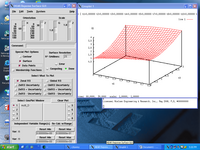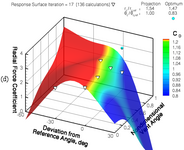| |
Multidisciplinary Data Analysis and Risk Assessment
NEAR Response Surface Package (NEAR RS)
 
(click on either picture to enlarge)
NEAR Response Surface Package (NEAR RS)
Multidimensional Metamodel
NEAR's Response Surface Package (NEAR RS) is a tool for multidimensional response surface representations based on limited experimental or numerical data, including data from heterogeneous sources. To visualize and spot trends in data of high dimension is difficult. A multidimensional response surface (RS) representation of the data provides interpolation between sparse data points, handles the representation of uncertainty in the data, and provides a method to generate one- or two-dimensional slices of the space for easy viewing. The analytical response surface provides a representation of the parameter space that is continuous and can be constructed on-the-fly. Its analytical nature makes it amenable to automated searches, and low-dimensional plots can be generated, based on suitable projections. A central issue to constructing an appropriate response surface model is the so-called curse of dimensionality, in which the number of data points required increases exponentially with the number of dimensions. This difficulty precludes the use of conventional schemes, such as polynomial approximations. The present software circumvents this problem by using a self-trained radial basis function network. The NEAR-developed technology consists of two modules: a response surface identification module, and a response surface evaluation module. A graphical user interface included with the response surface evaluator serves as a multidimensional viewer.
The response surface technology can be used to analyze trends and/or estimate the need for further data sampling based on uncertainty estimation. The latest version of the software can also be used to combine zonal response surfaces using fuzzy logic. The software is built on the GNU Octave framework and consists of a response surface graphical browser, an identification module in executable form, and scripts for querying and searching the response surface. The software includes full on-line HTML documentation.
Benefits
Accelerated design optimization.
Fast running software can be scripted for automatic processing methods or batch jobs.
Radial basis function (RBF) framework is well-suited to multidimensional data.
Easy to set up, with superior speed over multidimensional splines.
Data fusion capability.
System Requirements
The software has been tested on the following Linux distributions:
SuSE 7.1/8.0/8.1/9.0/9.1, RedHat 7.0/8.0/9.0, and Red Hat Enterprise Server 2.9/3.0.
Includes required installations of Octave/TkOctave.
License Fee
Licensing the software is subject to an agreement between NEAR (licensor) and the end_user (licensee).
Frequently Asked Questions
Applications
- Data Adaptivity / Sparse Data Sets
- Illustration of RS evolution as a function of data set enrichment is shown in Example 1.
- Data Fusion
- Blend data from disparate sources and view the global data model. See Example 2.
- Feature Extraction / Data Mining
- Uncertainty Modeling
Features
- Data Structure Flexibility and Use of Heterogeneous Data Sets
- Unstructured, sparse data sets are allowed.
- Conflict handling of data is automatic.
- Fully Analytic, Mathematical Data Description
- Results are smooth and continuous functions in all dimensions.
- Allows computation of derivatives in any dimension.
- Uncertainty Estimation / Risk Assessment Tool
- Response surface uncertainty can be used as a driver for decision making or in further populating data sets.
- Allows evaluation of RS in parameter areas where no data are present, driving the need for uncertainty estimation in all evaluations.
References:
- Reisenthel, P. H., Love, J. F., Lesieutre, D. J., and Childs, R. E., "Cumulative Global Metamodels with Uncertainty: a Tool for Aerospace Integration," NEAR Paper 403, CEIAT 2005-0019, 1st International Conference on Innovation and Integration in Aerospace Sciences, Queen's University, Belfast, Northern Ireland, UK, 4-5 Aug. 2005. Download Slide Presentation.
- Rodman, L. C., Reisenthel, P. H., Childs, R. E., "An Automated Documentation and Reporting System For CFD," AIAA 2002-0986 , Nielsen Engineering & Research, Mountain View, CA, Jan. 2002.
MDO Configuration Optimization
Payload Fairing Shape Optimization
Multidisciplinary Flight Simulation
Multidimensional Data Analysis and Risk Assesment
|
|
|

|





